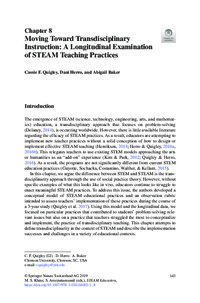Moving Toward Transdisciplinary InstructionA Longitudinal Examination of STEAM Teaching Practices
Cassie F. Quigley, Dani Herro, Abigail Baker
|
 |
 Diese Seite wurde seit 2 Jahren inhaltlich nicht mehr aktualisiert.
Unter Umständen ist sie nicht mehr aktuell.
Diese Seite wurde seit 2 Jahren inhaltlich nicht mehr aktualisiert.
Unter Umständen ist sie nicht mehr aktuell.
 Zusammenfassungen
Zusammenfassungen
 For years, the STEAM movement has been touted by businesses, universities, and even governments as a way to move beyond focusing on single disciplines such as science but instead toward multiple modes of problem-solving and viewpoints (Connor AM, Karmokar S, Whittington C. International Journal of Engineering Pedagog 5(2):37–47, 2015). However, STEAM education in the K-12 setting is still relatively new, which has led to a limited conceptual understanding of how to conceptualize, design, or enact STEAM education (Kim & Park, The effect of STEAM education on elementary school student’s creativity improvement. In Kim T, Stoica A, Fang W, Vasilakos T, Villalba J, Arnett K,… Kang B (eds), Computer applications for security, control and system engineering. Springer, Berlin/Heidelberg, pp 115–121. https://doi.org/10.1007/978-3-642-35264-5_16, 2012). This limited understanding often leads teachers to use existing STEM models and attempt to “add-on” experiences with the arts or humanities (Henriksen D, DeSchryver M, Mishra P, Deep-Play Research Group, TechTrends 59:5, 2015). In response, the authors have spent the last 3 years conducting a longitudinal study exploring how STEAM teaching practices are enacted in a variety of settings in the southeast of the United States in order to understand teachers’ implementation strategies (Herro D, Quigley C, Prof Dev Educ, 1–23, 2016a, On the Horizon 24:190–204, 2016b; Quigley C, Herro D, J Sci Educ Technol 25:410–426, 2016; Quigley, Herro, & Jamil. 2017). Based on a qualitative study examining classroom observations, teachers’ reflective journals during STEAM implementation, and focus-group teacher interviews, this chapter will highlight vignettes of these classrooms including elementary and secondary school examples as well as discipline-focused STEAM examples. The goal of this chapter is to inform teacher educators and provide support to teachers who are attempting to implement this transdisciplinary approach to learning.
For years, the STEAM movement has been touted by businesses, universities, and even governments as a way to move beyond focusing on single disciplines such as science but instead toward multiple modes of problem-solving and viewpoints (Connor AM, Karmokar S, Whittington C. International Journal of Engineering Pedagog 5(2):37–47, 2015). However, STEAM education in the K-12 setting is still relatively new, which has led to a limited conceptual understanding of how to conceptualize, design, or enact STEAM education (Kim & Park, The effect of STEAM education on elementary school student’s creativity improvement. In Kim T, Stoica A, Fang W, Vasilakos T, Villalba J, Arnett K,… Kang B (eds), Computer applications for security, control and system engineering. Springer, Berlin/Heidelberg, pp 115–121. https://doi.org/10.1007/978-3-642-35264-5_16, 2012). This limited understanding often leads teachers to use existing STEM models and attempt to “add-on” experiences with the arts or humanities (Henriksen D, DeSchryver M, Mishra P, Deep-Play Research Group, TechTrends 59:5, 2015). In response, the authors have spent the last 3 years conducting a longitudinal study exploring how STEAM teaching practices are enacted in a variety of settings in the southeast of the United States in order to understand teachers’ implementation strategies (Herro D, Quigley C, Prof Dev Educ, 1–23, 2016a, On the Horizon 24:190–204, 2016b; Quigley C, Herro D, J Sci Educ Technol 25:410–426, 2016; Quigley, Herro, & Jamil. 2017). Based on a qualitative study examining classroom observations, teachers’ reflective journals during STEAM implementation, and focus-group teacher interviews, this chapter will highlight vignettes of these classrooms including elementary and secondary school examples as well as discipline-focused STEAM examples. The goal of this chapter is to inform teacher educators and provide support to teachers who are attempting to implement this transdisciplinary approach to learning. Dieses Kapitel erwähnt ...
Dieses Kapitel erwähnt ...
 Begriffe KB IB clear |  design thinking
, design thinking
,  Kreativität Kreativität creativity creativity
|
 Anderswo finden
Anderswo finden
 Volltext dieses Dokuments
Volltext dieses Dokuments
 |  Moving Toward Transdisciplinary Instruction: A Longitudinal Examination of STEAM Teaching Practices: Artikel als Volltext bei Springerlink ( Moving Toward Transdisciplinary Instruction: A Longitudinal Examination of STEAM Teaching Practices: Artikel als Volltext bei Springerlink ( : :  , 280 kByte; , 280 kByte;  : :  ) ) |
 Anderswo suchen
Anderswo suchen 
 Beat und dieses Kapitel
Beat und dieses Kapitel
Beat hat Dieses Kapitel während seiner Zeit am Institut für Medien und Schule (IMS) ins Biblionetz aufgenommen. Beat besitzt kein physisches, aber ein digitales Exemplar. Eine digitale Version ist auf dem Internet verfügbar (s.o.). Aufgrund der wenigen Einträge im Biblionetz scheint er es nicht wirklich gelesen zu haben. Es gibt bisher auch nur wenige Objekte im Biblionetz, die dieses Werk zitieren.










 Biblionetz-History
Biblionetz-History